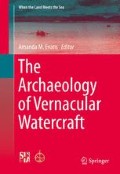Abstract
Ships have played an important role in the development of human history, transporting people and cargoes into ever-increasing spheres of interaction. Data extracted from vernacular watercraft in the archaeological record can be used to develop and modify models of past human behavior. Theoretical constructs that relate economics, environment, and cultural systems can be used to relate particular data extracted from shipwreck sites to broader questions of human culture. Specifically, the relationship between cultural ecology and ship design demonstrates the dynamic nature of ships as an indicator of adaptive social processes. Jamaica sloops from the colonial Caribbean are one example of vernacular ships where the interactive variables exerting pressure on technological systems demonstrate the manner in which ships reflect adaptations to new environments.
Access this chapter
Tax calculation will be finalised at checkout
Purchases are for personal use only
References
Adams, J. (2001). Ships and boats as archaeological source material. World Archaeology, 32(3), 292–310.
Annas, G. J., & Elias, S. (1999). Thalidomide and the Titanic: Reconstructing the technology tragedies of the twentieth century. American Journal of Public Health, 89(1), 98–101.
Archbold, R., McCauley, D., & Lord, W. (1997). Last dinner on the titanic: Menus and recipes from the great liner. New York: Hyperion Books.
Baker, W. A. (1966). Sloops and shallops. Barre, MA: Barre.
Bass, G. F. (1983). A plea for historical particularism in nautical archaeology. In R. Gould (Ed.), Shipwreck anthropology (pp. 91–104). Albequerque, NM: University of New Mexico Press.
Biel, S. (1996). A cultural history of the titanic disaster. New York: W.W. Norton.
Blanton, D. B. (2003). The weather is fine, wish you were here, because I’m the last one alive. In M. Rockman & J. Steele (Eds.), Colonization of unfamiliar landscapes: The archaeology of adaptation (pp. 190–200). London: Routledge.
Butzer, K. (1982). Archaeology as human ecology. Cambridge, England: Cambridge University Press.
Cederlund, C. O., & Hocker, F. M. (2006). Vasa I: The archaeology of a Swedish royal ship of 1628. Stockholm, Sweden: Statens Maritima Museer.
Chapelle, H. I. (1967). The search for speed under sail 1700-1855. New York: W.W. Norton.
Chase-Dunn, C., & Grimes, P. (1995). World-systems analysis. Annual Review of Sociology, 21, 387–417.
Cordingly, D. (1995). Under the black flag: The romance and the reality of life among the pirates. New York: Harcourt Brace.
Dobres, M.-A. (2000). Technology and social agency: Outlining a practice framework for archaeology. Oxford, England: Blackwell.
Dornan, J. L. (2002). Agency and archaeology: Past, present, and future directions. Journal of Archaeological Method and Theory, 9, 303–329.
Eustice, R. M., Singh, H., Leonard, J. J., & Walter, M. R. (2010). Visually mapping the RMS titanic: Conservative covariance estimates for SLAM information filters. International Journal of Robotics Research, 29, 941–957.
Evans, A. M. (2005). Institutionalized piracy and the development of the Jamaica Sloop, 1630-1743. Master’s thesis, Department of Anthropology, Florida State University, Tallahassee, FL.
Gibbins, D., & Adams, J. (2001). Shipwrecks and maritime archaeology. World Archaeology, 32(3), 279–291.
Gould, R. (1983). Looking below the surface: Shipwreck archaeology as anthropology. In R. Gould (Ed.), Shipwreck anthropology (pp. 3–22). Albequerque, NM: University of New Mexico Press.
Horrell, C. E. (2005). Plying the Waters of Time: Maritime Archaeology and History on the Florida Gulf Coast. Doctoral dissertation, Department of Anthropology, Florida State University, Tallahassee, FL.
Jarvis, M. J. (1990). ‘The fastest vessels in the World’: The origin and evolution of the Bermuda sloop, 1620-1800. Bermuda Journal of Archaeology and Maritime History, 2, 31–50.
Kaplan, E. H. (1988). A field guide to southeastern and Caribbean seashores: Cape Hatteras to the gulf coast, Florida, and the Caribbean. Boston, MA: Houghton Mifflin.
Konstam, A. (1999). The history of shipwrecks. Guilford, CT: Lyons Press.
Lord, W. (2004). A night to remember. New York: Holt Paperbacks.
Meltzer, D. (2003). Lessons in landscape learning. In M. Rockman & J. Steele (Eds.), Colonization of unfamiliar landscapes: The archaeology of adaptation (pp. 222–241). London: Routledge.
Ortner, S. B. (1984). Theory in anthropology since the sixties. Society for Comparative Study of Society and History, 26(1), 126–166.
Richards, N. (2008). Ship’s graveyards: Abandoned watercraft and the archaeological site formation process. Gainesville, FL: University Press of Florida.
Richardson, B. C. (1992). The Caribbean in the wider world, 1492-1992: A regional geography. Cambridge, England: Cambridge University Press.
Schmidt, P. R., & Mrozowski, S. A. (1983). History, smugglers, change and shipwrecks. In R. Gould (Ed.), Shipwreck anthropology (pp. 143–172). Albuquerque, FL: University of New Mexico Press.
Smith, R. C., Spirek, J., Bratten, J., & Scott-Ireton, D. (1999). The Emanuel point ship: Archaeological investigations 1992-1995. Tallahassee, FL: Florida Department of State, Bureau of Archaeological Research.
Stanbury, M. (Ed.). (2003). The Barque Eglinton: Wrecked Western Australia 1852. Australian National Centre of Excellence for Maritime Archaeology, Special Publication No. 6; The Australasian Institute for Maritime Archaeology, Special Publication No. 13. Fremantle: Western Australia Maritime Museum.
Steele, J., & Rockman, M. (2003). Where do we go from here: Modelling the decision-making process during exploratory dispersal. In M. Rockman & J. Steele (Eds.), Colonization of unfamiliar landscapes: The archaeology of adaptation (pp. 130–143). London: Routledge.
Wallerstein, I. (2004). World-systems analysis: An introduction. Durham, NC: Duke University Press.
Ward, C. A. (2004). Boatbuilding in ancient Egypt. In F. Hocker & C. Ward (Eds.), Towards a philosophy of ancient shipbuilding (pp. 13–24). College Station, TX: Texas A&M University Press.
Author information
Authors and Affiliations
Corresponding author
Editor information
Editors and Affiliations
Rights and permissions
Copyright information
© 2016 Springer Science+Business Media New York
About this chapter
Cite this chapter
Evans, A.M. (2016). Improvise, Adapt, Overcome: Vernacular Boats as Environmental Adaptations. In: Evans, A. (eds) The Archaeology of Vernacular Watercraft. When the Land Meets the Sea. Springer, New York, NY. https://doi.org/10.1007/978-1-4939-3563-5_2
Download citation
DOI: https://doi.org/10.1007/978-1-4939-3563-5_2
Published:
Publisher Name: Springer, New York, NY
Print ISBN: 978-1-4939-3561-1
Online ISBN: 978-1-4939-3563-5
eBook Packages: Social SciencesSocial Sciences (R0)

